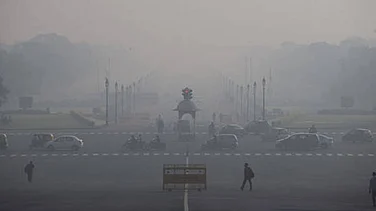Every winter Delhi struggles to maintain air quality, prompting the government to implement strategic measures to curb pollution levels. Keeping the issue in mind, Delhi Environment Minister Gopal Rai, on Wednesday, unveiled the Winter Action Plan which encompasses a range of initiatives designed to address the urgent need for cleaner air in the national capital.
The theme for this year's Winter Action Plan is “Mil Kar Chale, Pradushan Se Ladein,” calling for collective action against pollution.
The Winter Action Plan is structured around 21 key focus areas that outline specific measures to combat air pollution. While speaking on the plan, Environment Minister Rai said, "A ban on firecrackers will be implemented this year as well and once the notification is issued, the ban will be fully enforced. GRAP (Graded Response Action Plan) stages will come into effect and 588 teams have been formed to control the open burning of garbage. We will encourage work from home and voluntarily reducing the use of private vehicles. If necessary, the odd-even (road rationalisation) scheme will be implemented, and artificial rain is also an option that we are exploring."
Minister Gopal Rai also said that the state government is planning to explore artificial rain in November, when the pollution will be at its peak. "We have written a letter to the Union Environment Minister asking permission to implement artificial rain during winter. We want to prepare for artificial rains between November 1 to November 15, when the pollution levels are expected to peak due to the aftermath of Diwali celebrations and stubble burning," he said. The Union Minister is yet to respond to the proposal.
The artificial rain plan was proposed IN 2023 by Manindra Aggrawal, a professor in the Department of Computer Science and Engineering at IIT Kanpur. Professor Aggrawal's project aimed at alleviating the deteriorating air quality and clease the atmosphere. The Delhi government has shown keen interest in the project and had requested a detailed proposal.
The winter action plan focuses on a multi-faceted approach to tackle air pollution during the winter season in Delhi. It features various technological measures including drone monitoring, road-sweeping machines, and deployment of mobile anti-smog guns to combat air pollution. An anti-dust campaign and the formation of a special task force are also proposed in the recently launched action plan. Through advanced technology and stringent regulations, the government is aiming to improve air quality and protect public health which usually deteriorates during winter.
Delhi’s Winter Action Plan | Key Highlights
1. Drone monitoring at 13 pollution hotspots: To enhance monitoring capabilities, drones will be deployed to monitor pollution levels in high-traffic and pollution-prone areas. "This year, for the first time, we will be using drones to monitor pollution at 13 major hotspots across Delhi,” the environment minister said.
2. Formation of 6-member task force: A special task force, comprising six members, will be formed to oversee pollution levels and ensure timely actions are taken based on the monitoring results.
3. Deployment of mobile anti-smog guns: The action plan includes an increased frequency of mobile anti-smog guns, specifically in identified pollution hotspots. These guns spray water mist to capture airborne particulate matter, helping to improve air quality in critical areas.
4. Anti-dust campaign: An extensive anti-dust campaign will be initiated from October 7. All private and government agencies will have to compulsorily comply otherwise actions will be taken.
5. Road-sweeping machines: 85 road-sweeping machines along with 500 water-sprinkling machines are being deployed throughout Delhi to tackle dust pollution. Water sprinkling will be increased by three times in the months of November and December.
6. Ban on firecrackers: Like every year, a ban on firecrackers will be implemented as a part of pollution control measures.
7. GRAP stages: The Graded Response Action Plan (GRAP) will come into effect, outlining specific actions based on pollution levels.
8. Artificial rain: To mitigate the air quality crisis, the Delhi government is considering the use of artificial rain. This initiative is especially focused on the period between November 1-15, coinciding with Diwali and the onset of stubble burning.
9. Green app: A green war room and a Green Delhi App will also be launched.
10. ‘Harit’ campaign: Under the winter action plan, Delhi will launch four campaigns - “Harit Kalash Yatra”, a campaign to increase awareness about plantation; “E-vehicle parade”, to raise awareness about e-vehicles; Anti-pollution march; and “Red light on, Gaadi off.” The state government is also planning to introduce an award called the “Harit Ratna” award for those who perform best in controlling air pollution.
11. Open burning of garbage: To combat the open burning of waste 588 teams have been formed to enforce regulations and control such practices across the city.
12. Stubble burning: To control pollution caused by stubble burning, Bio-decomposers will be sprayed across 5,000 acres of land. Meanwhile, the Supreme Court has asked the Commission for Air Quality Management (CAQM) to submit a report stating the steps taken to curb pollution due to stubble burning.


















